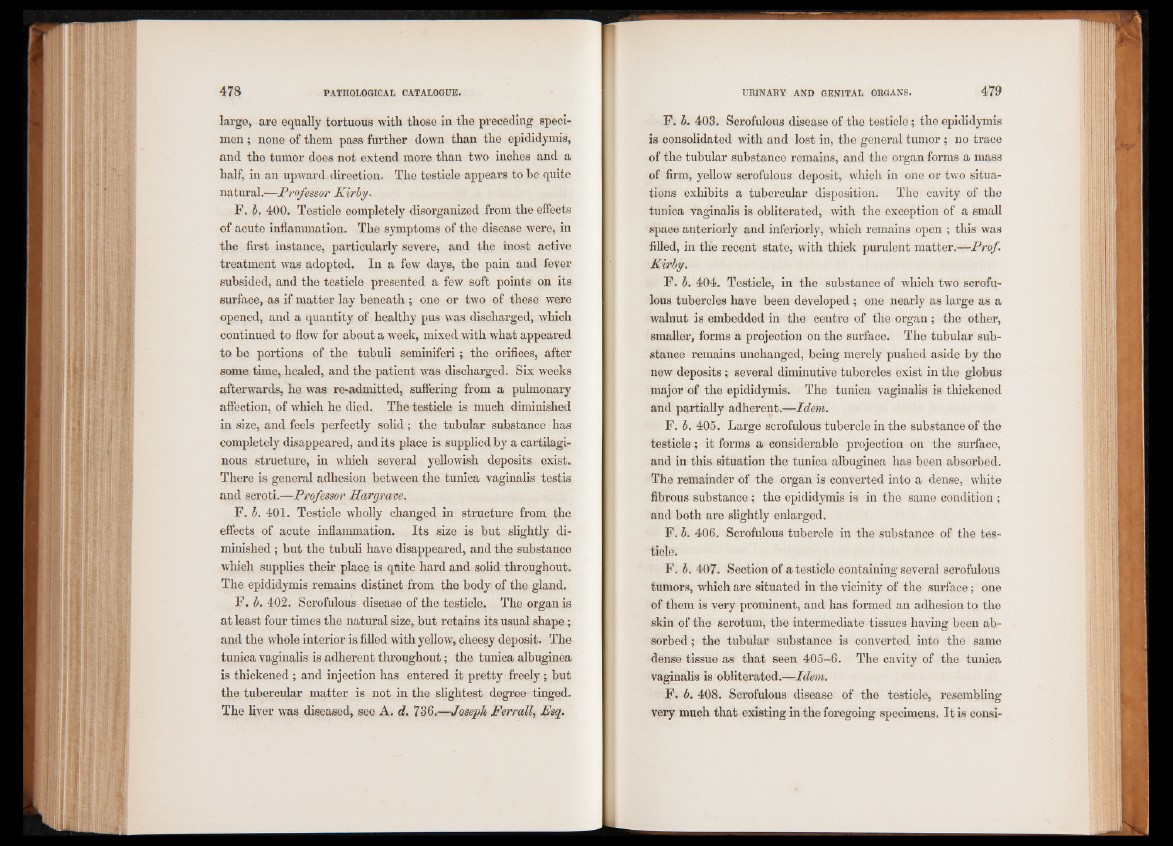
large, are equally tortuous with those in the preceding specimen
; none of them pass further down than the epididymis,
and the tumor does not extend more than two inches and a
half, in an upward direction. The testicle appears to he quite
natural.—Professor Kirby.
F. b. 400. Testicle completely disorganized from the effects
of acute inflammation. The symptoms of the disease were, in
the first instance, particularly severe, and the most active
treatment was adopted. In a few days, the pain and fever
subsided, and the testicle presented a few soft points on its
surface, as if matter lay beneath ; one or two of these were
opened, and a quantity of healthy pus was discharged, which
continued to flow for about a week, mixed with what appeared
to be portions of the tubuli seminiferi ; the orifices, after
some time, healed, and the patient was discharged. Six weeks
afterwards, he was re-admitted, suffering from a pulmonary
affection, of which he died. The testicle is much diminished
in size, and feels perfectly solid; the tubular substance has
completely disappeared, and its place is supplied by a cartilaginous
structure, in which several yellowish deposits exist.
There is general adhesion between the tunica vaginalis testis
and scroti.—Professor Hargrave.
F. b. 401. Testicle wholly changed in structure from the
effects of acute inflammation. Its size is but slightly diminished
; but the tubuli have disappeared, and the substance
which supplies their place is quite hard and solid throughout.
The epididymis remains distinct from the body of the gland.
F. b. 402. Scrofulous disease of the testicle. The organ is
at least four times the natural size,, but retains its usual shape;
and the whole interior is filled with yellow, cheesy deposit. The
tunica vaginalis is adherent throughout; the tunica albuginea
is thickened ; and injection has entered it pretty freely; but
the tubercular matter is not in the slightest degree tinged.
The liver was diseased, see A. d. 736.—Joseph Ferrall, Esq.
F. b. 403. Scrofulous disease of the testicle; the epididymis
is consolidated with and lost in, the general tumor ; no trace
of the tubular substance remains, and the organ forms a mass
of firm, yellow scrofulous deposit, which in one or two situations
exhibits a tubercular disposition. The cavity of the
tunica vaginalis is obliterated, with the exception of a small
space anteriorly and inferiorly, which remains open ; this was
filled, in the recent state, with thick purulent matter.—Prof.
Kirby.
F. b. 404. Testicle, in the substance of which two scrofulous
tubercles have been developed ; one nearly as large as a
walnut is embedded in the centre of the organ ; the other,
smaller, forms a projection on the surface. The tubular substance
remains unchanged, being merely pushed aside by the
new deposits; several diminutive tubercles exist in the globus
major of the epididymis. The tunica vaginalis is thickened
and partially adherent.—Idem.
F. b. 405. Large scrofulous tubercle in the substance of the
testicle; it forms a considerable projection on the surface,
and in this situation the tunica albuginea has been absorbed.
The remainder of the organ is converted into a dense, white
fibrous substance ; the epididymis is in the same condition ;
and both are slightly enlarged.
F. b. 406. Scrofulous tubercle in the substance of the testicle.
F. b. 407. Section of a testicle containing several scrofulous
tumors, which are situated in the vicinity of the surface; one
of them is very prominent, and has formed an adhesion to the
skin of the scrotum, the intermediate tissues having been absorbed
; the tubular substance is converted into the same
dense tissue as that seen 405-6. The cavity of the tunica
vaginalis is obliterated.—Idem.
F. b. 408. Scrofulous disease of the testicle, resembling
very much that existing in the foregoing specimens. It is consi